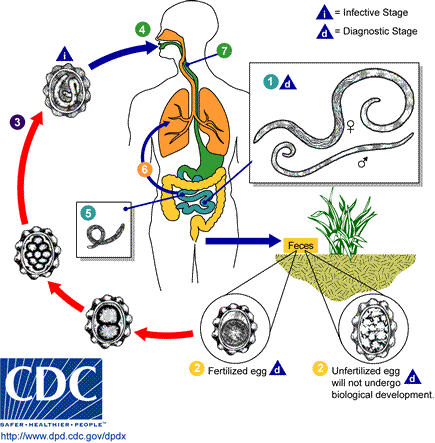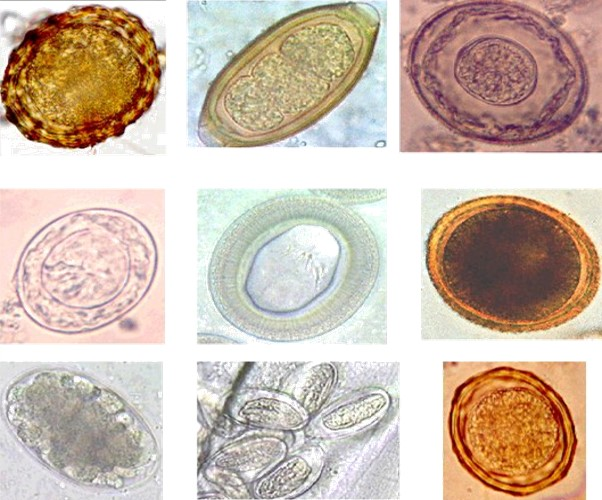|
Helminthiasis
Helminthiasis, also known as worm infection, is any macroparasite, macroparasitic disease of humans and other animals in which a part of the body is infected with parasitism, parasitic worms, known as helminths. There are numerous species of these parasites, which are broadly classified into cestoda, tapeworms, trematoda, flukes, and nematode, roundworms. They often live in the gastrointestinal tract of their host (biology), hosts, but they may also burrow into other organ (anatomy), organs, where they induce physiological damage. Soil-transmitted helminthiasis and schistosomiasis are the most important helminthiases, and are among the neglected tropical diseases. These group of helminthiases have been targeted under the joint action of the world's leading pharmaceutical industry, pharmaceutical companies and non-governmental organizations through a project launched in 2012 called the London Declaration on Neglected Tropical Diseases, which aimed to control or eradicate certain n ... [...More Info...] [...Related Items...] OR: [Wikipedia] [Google] [Baidu] |
Neglected Tropical Diseases
Neglected tropical diseases (NTDs) are a diverse group of tropical infections that are common in low-income populations in developing regions of Africa, Asia, and the Americas. They are caused by a variety of pathogens, such as viruses, bacteria, protozoa, and parasitic worms (helminths). These diseases are contrasted with the "big three" infectious diseases (HIV/AIDS, tuberculosis, and malaria), which generally receive greater treatment and research funding. In sub-Saharan Africa, disease burden, the effect of neglected tropical diseases as a group is comparable to that of malaria and tuberculosis. NTD co-infection can also make HIV/AIDS and tuberculosis more deadly. Some treatments for NTDs are relatively inexpensive. For example, praziquantel for schistosomiasis costs about US $0.20 per child per year. Nevertheless, in 2010 it was estimated that control of neglected diseases would require funding of between US$2 billion and $3 billion over the subsequent five to sev ... [...More Info...] [...Related Items...] OR: [Wikipedia] [Google] [Baidu] |
Soil-transmitted Helminthiasis
Soil-transmitted helminthiasis is a type of worm infection (helminthiasis) caused by different species of roundworms. It is caused specifically by worms transmitted through soil contaminated with faecal matter and are known as soil-transmitted helminths. Three types of soil-transmitted helminthiasis can be distinguished: ascariasis, hookworm infection and whipworm infection. These three types of infection are therefore caused by the large roundworm '' A. lumbricoides, ''the hookworms'' Necator americanus ''or'' Ancylostoma duodenale'' and by the whipworm '' Trichuris trichiura''. It has become the most common parasitic disease of humans worldwide. Approximately two billion people (about a fourth of global population) are infected as of the latest estimate, and four billion at risk, surpassing even the all-time most prevalent parasitic disease, malaria. The largest numbers of cases occur in impoverished rural areas of Sub-Saharan Africa, Latin America, Southeast Asia, and Chi ... [...More Info...] [...Related Items...] OR: [Wikipedia] [Google] [Baidu] |
Helminth
Parasitic worms, also known as helminths, are a polyphyletic group of large macroparasites; adults can generally be seen with the naked eye. Many are intestinal worms that are soil-transmitted and infect the gastrointestinal tract. Other parasitic worms such as schistosomes reside in blood vessels. Some parasitic worms, including leeches and monogeneans, are ectoparasites thus, they are not classified as helminths, which are endoparasites. Parasitic worms live in and feed in living hosts. They receive nourishment and protection while disrupting their hosts' ability to absorb nutrients. This can cause weakness and disease in the host, and poses a global health and economic problem. Parasitic worms cannot reproduce entirely within their host's body; they have a life cycle that includes some stages that need to take place outside of the host. Helminths are able to survive in their mammalian hosts for many years due to their ability to manipulate the host's immune respon ... [...More Info...] [...Related Items...] OR: [Wikipedia] [Google] [Baidu] |
London Declaration On Neglected Tropical Diseases
The London Declaration on Neglected Tropical Diseases was a collaborative disease eradication programme launched on 30 January 2012 in London. It was inspired by the World Health Organization roadmap to eradicate or prevent transmission for neglected tropical diseases by the year 2020. Officials from WHO, the World Bank, the Bill & Melinda Gates Foundation, the world's 13 leading pharmaceutical companies, and government representatives from US, UK, United Arab Emirates, Bangladesh, Brazil, Mozambique and Tanzania participated in a joint meeting at the Royal College of Physicians to launch this project. The meeting was spearheaded by Margaret Chan, Director-General of WHO, and Bill Gates, Co-Chair of the Bill & Melinda Gates Foundation. This declaration was the largest coordinated effort to date in health issues and it aimed to eliminate or control 10 neglected diseases by 2020 by providing more than US$785 million to support research and development. These diseases are most ram ... [...More Info...] [...Related Items...] OR: [Wikipedia] [Google] [Baidu] |
Ascariasis LifeCycle - CDC Division Of Parasitic Diseases
Ascariasis is a disease caused by the parasitic roundworm ''Ascaris lumbricoides''. Infections have no symptoms in more than 85% of cases, especially if the number of worms is small. Symptoms increase with the number of worms present and may include shortness of breath and fever at the beginning of the disease. These may be followed by symptoms of abdominal swelling, abdominal pain, and diarrhea. Children are most commonly affected, and in this age group the infection may also cause poor weight gain, malnutrition, and learning problems. Infection occurs by ingesting food or drink contaminated with ''Ascaris'' eggs from feces. The eggs hatch in the intestines, the larvae burrow through the gut wall, and migrate to the lungs via the blood. There they break into the alveoli and pass up the trachea, where they are coughed up and may be swallowed. The larvae then pass through the stomach a second time into the intestine, where they become adult worms. It is a type of soil-transmit ... [...More Info...] [...Related Items...] OR: [Wikipedia] [Google] [Baidu] |
Ascariasis
Ascariasis is a disease caused by the parasitic roundworm ''Ascaris lumbricoides''. Infections have no symptoms in more than 85% of cases, especially if the number of worms is small. Symptoms increase with the number of worms present and may include shortness of breath and fever at the beginning of the disease. These may be followed by symptoms of abdominal swelling, abdominal pain, and diarrhea. Children are most commonly affected, and in this age group the infection may also cause poor weight gain, malnutrition, and learning problems. Infection occurs by ingesting food or drink contaminated with ''Ascaris'' eggs from feces. The eggs hatch in the intestines, the larvae burrow through the gut wall, and migrate to the lungs via the blood. There they break into the Pulmonary alveolus, alveoli and pass up the Vertebrate trachea, trachea, where they are coughed up and may be swallowed. The larvae then pass through the stomach a second time into the intestine, where they become adul ... [...More Info...] [...Related Items...] OR: [Wikipedia] [Google] [Baidu] |
Trichuris Trichiura
''Trichuris trichiura, Trichocephalus trichiuris'' or whipworm, is a parasitic roundworm (a type of helminth) that causes trichuriasis (a type of helminthiasis which is one of the neglected tropical diseases) when it infects a human large intestine. It is commonly known as the ''whipworm'' which refers to the shape of the worm; it looks like a whip with wider "handles" at the posterior end. The helminth is also known to cause rectal prolapse. Life cycle The female ''T. trichiura'' produces 2,000–10,000 single-celled eggs per day. Eggs are deposited from human feces to soil where, after two to three weeks, they become embryonated and enter the "infective" stage. These embryonated infective eggs are ingested by hand-mouth or through fomites and hatch in the human small intestine, exploiting the intestinal microflora as a stimulus to hatching. This is the location of growth and molting. The infective larvae penetrate the villi and continue to develop in the small intestine. ... [...More Info...] [...Related Items...] OR: [Wikipedia] [Google] [Baidu] |
Schistosomiasis
Schistosomiasis, also known as snail fever, bilharzia, and Katayama fever is a neglected tropical helminthiasis, disease caused by parasitism, parasitic Schistosoma, flatworms called schistosomes. It affects both humans and animals. It affects the urinary tract or the intestines. Symptoms include abdominal pain, diarrhea, blood in stool, bloody stool, or hematuria, blood in the urine. Those who have been Infection, infected for a long time may experience liver damage, kidney failure, infertility, or bladder cancer. In children, schistosomiasis may cause failure to thrive, poor growth and learning disability, learning difficulties. Schistosomiasis is spread by contact with fresh water contaminated with parasites. These parasites are released from infected freshwater snails. The disease is especially common among children in Developing country, underdeveloped and developing countries because they are more likely to play in contaminated water. Schistosomiasis is also common among ... [...More Info...] [...Related Items...] OR: [Wikipedia] [Google] [Baidu] |
Nematode
The nematodes ( or ; ; ), roundworms or eelworms constitute the phylum Nematoda. Species in the phylum inhabit a broad range of environments. Most species are free-living, feeding on microorganisms, but many are parasitic. Parasitic worms (helminths) are the cause of soil-transmitted helminthiases. They are classified along with arthropods, tardigrades and other moulting animals in the clade Ecdysozoa. Unlike the flatworms, nematodes have a tubular digestive system, with openings at both ends. Like tardigrades, they have a reduced number of Hox genes, but their sister phylum Nematomorpha has kept the ancestral protostome Hox genotype, which shows that the reduction has occurred within the nematode phylum. Nematode species can be difficult to distinguish from one another. Consequently, estimates of the number of nematode species are uncertain. A 2013 survey of animal biodiversity suggested there are over 25,000. Estimates of the total number of extant species are su ... [...More Info...] [...Related Items...] OR: [Wikipedia] [Google] [Baidu] |
Cestoda
Cestoda is a class of parasitic worms in the flatworm phylum (Platyhelminthes). Most of the species—and the best-known—are those in the subclass Eucestoda; they are ribbon-like worms as adults, commonly known as tapeworms. Their bodies consist of many similar units known as proglottids—essentially packages of eggs which are regularly shed into the environment to infect other organisms. Species of the other subclass, Cestodaria, are mainly fish-infecting parasites. All cestodes are parasitic; many have complex life histories, including a stage in a definitive (main) host in which the adults grow and reproduce, often for years, and one or two intermediate stages in which the larvae develop in other hosts. Typically the adults live in the digestive tracts of vertebrates, while the larvae often live in the bodies of other animals, either vertebrates or invertebrates. For example, '' Diphyllobothrium'' has at least two intermediate hosts, a crustacean and then one or mo ... [...More Info...] [...Related Items...] OR: [Wikipedia] [Google] [Baidu] |
Necator Americanus
''Necator americanus'' is a species of hookworm (a type of helminth) commonly known as the New World hookworm. Like other hookworms, it is a member of the phylum Nematoda. It is an obligatory parasitic nematode that lives in the small intestine of human hosts. Necatoriasis—a type of helminthiasis Helminthiasis, also known as worm infection, is any macroparasite, macroparasitic disease of humans and other animals in which a part of the body is infected with parasitism, parasitic worms, known as helminths. There are numerous species of the ...—is the term for the condition of being host to an infestation of a species of ''Necator''. Since ''N. americanus'' and ''Ancylostoma duodenale'' (also known as Old World hookworm) are the two species of hookworms that most commonly infest humans, they are usually dealt with under the collective heading of "hookworm infection". They differ most obviously in geographical distribution, structure of mouthparts, and relative size. ''Ne ... [...More Info...] [...Related Items...] OR: [Wikipedia] [Google] [Baidu] |






